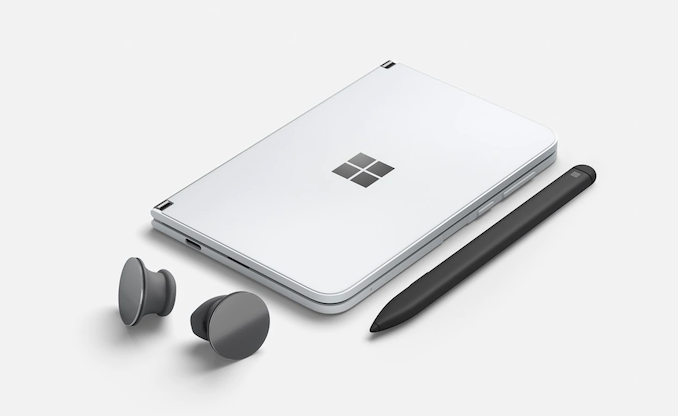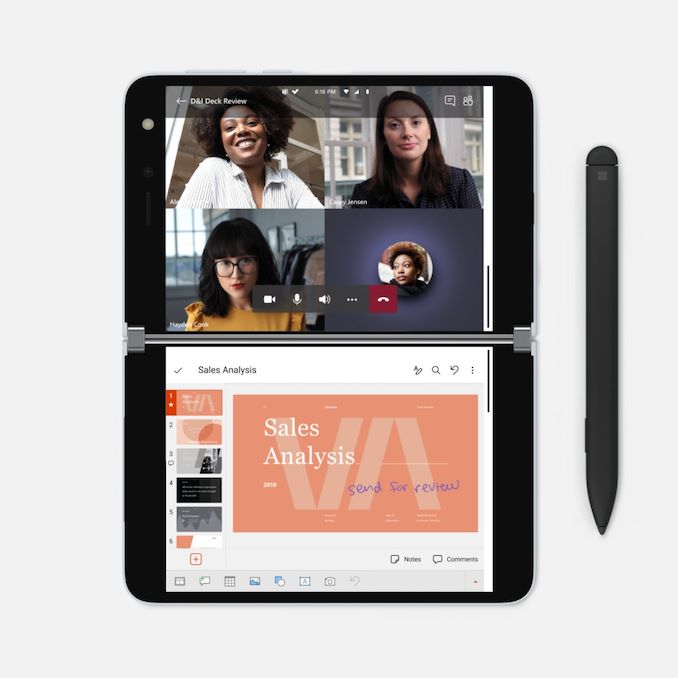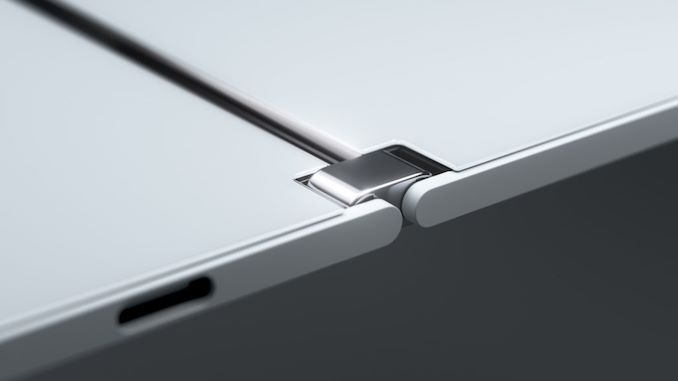Microsoft Opens Pre-Orders for Surface Duo - US Only
by Andrei Frumusanu on August 12, 2020 10:30 AM EST
Late last year in October, Microsoft had announced the Surface Duo, the company’s first ever Android device and first-party smartphone (if you can call it that) release in years. What makes the Surface Duo special is its symmetric dual-screen nature and 360° hinge mechanism that allows the device to fold itself shut like a book – to fully opening itself up with two opposing displays. Today Microsoft is finally making the Surface Duo available for pre-order – although availability will be limited to the US.
| Microsoft Surface Duo | ||
| Surface Duo | ||
| SoC | Qualcomm Snapdragon 855 1x Kryo 485 (Cortex-A76) @ 2.84GHz 3x Kryo 485 (Cortex-A76) @ 2.42GHz 4x Kryo 485 (Cortex-A55) @ 1.80GHz Adreno 640 @ 585MHz |
|
| DRAM | 6GB LPDDR4X | |
| Display | Dual 5.6" solid OLED with 360° hinge 1800 x 1350 (4:3) Unfolded 8.1" effective diagonal at 2700x1800 (3:2) |
|
| Size | Height | 145.2 mm |
| Width | 93.3 mm (closed) - 186.9 mm (open) | |
| Depth | 9.9mm (closed) - 4.8 mm (open) | |
| Weight | 250 grams | |
| Battery Capacity | 3577mAh total (dual cells) | |
| Wireless Charging | - | |
| Rear Cameras | ||
| Main | 11MP 1.0 µm f/2.0 |
|
| Telephoto | - | |
| Wide | - | |
| Extra | - | |
| Front Camera | - | |
| Storage | 128 / 256 GB UFS 3.0 | |
| I/O | USB-C | |
| Wireless (local) | 802.11ac Wave 2 Wi-Fi Bluetooth 5.0 LE + NFC |
|
| Cellular | (Category 12/5) DL = 1200Mbps 5x20MHz CA, 256-QAM UL = 150Mbps 2x20MHz CA, 64-QAM |
|
| Other Features | It folds | |
| Dual-SIM | 1x nanoSIM + eSIM | |
| Launch Price | $1399 | |
Starting off with the uninteresting stuff – the internal hardware of the Surface Duo isn’t all that exciting as it features a last generation Snapdragon 855 SoC. Given the device’s early announcement last year it seems Microsoft took a long time to bring the device to market. We’re seeing a standard amount of DRAM and storage space with 6GB and either 128GB or 256GB options. All in all there’s nothing too special about the internals here and are in line with 2019 flagships.
The device’s key characteristic is naturally its symmetrical folding design with two 5.6” 1800 x 1350 resolution OLED screens. Although we call this a folding device, this doesn’t actually apply to the displays as they’re two distinct units covered with solid glass.
Further unique to the design is the hinge mechanism which is symmetrical as well – it allows for a full 360° tilt of the two sides, meaning you can have the device either fully shut, or you can have it fully opened with both screen facing outwards.
Microsoft opted for relatively unusual form-factors here as the screens are each 4:3 – and when opened up it gives you a sort of effective 8.1” diagonal 3:2 surface to work with.
The dimensions of the device come at 145.2mm height in portrait mode, and one side is 93.3mm wide, which opens up till 186.9mm. Each half is extremely thin at only 4.8mm meaning that even when folded it remains a relatively reasonable 9.9mm in thickness.
The device’s 360° folding nature means that the internal screen surface can face completely outwards, and Microsoft took advantage of this for their camera design, of which the Surface Duo only has a single unit. The 11MP 1µm pixel f/2.0 standard wide-angle unit is relatively conservative in specifications, but that’s the compromise that had to be made to fit into a 4.8mm thick chassis and not having the possibility to employ a camera bump.
Microsoft positions the Surface Duo as a productivity device, and its first-party applications such as the Microsoft 365 suite will be optimised for the experience. This seemingly will be the deciding factor as to how the Surface Duo will be received, as it represents quite a niche device market.
The Surface Duo is available for pre-order now at a very high price of $1399, with availability only in the US and compatibility with AT&T, T-Mobile and Verizon, with availability starting September 10th.
The device’s high price and relatively lacklustre specifications will likely result in limited adoption amongst users- and the device in general feels more like an experiment than a product that’s aimed at commercial success.













71 Comments
View All Comments
PeachNCream - Wednesday, August 12, 2020 - link
There are no bad products, only bad prices. The latter half of that statement applies here, but this is a new thing (ignoring the Nintendo DS and several other similar tech gadgets) and is a niche which makes the cost vaguely excusable for those that really badly want it.ingwe - Wednesday, August 12, 2020 - link
I had a rough reaction to the price, but I think I agree with you on this one. It is unique and first gen. They won't sell that many of them and if it does well in the limited market they are looking at, they will bring the price down in the future. This definitely isn't for me though.DigitalFreak - Wednesday, August 12, 2020 - link
Don't count on new versions being cheaper. That doesn't happen with the rest of the Surface device line.GiantPandaMan - Wednesday, August 12, 2020 - link
In the PC space, Microsoft doesn't want to piss off their hardware partners; hence the lack of aggressive pricing. They have no such limitations in the phone space. I could see this being used by businesses and getting steep discounts for their white collar workers.close - Thursday, August 13, 2020 - link
I can't imagine many white collar workers craving for a device with 2 huge screens and a 3577mAh battery. Assuming I was in the market for this form factor I could live with older WiFi or not the latest SoC. But that battery makes it useless.At best they want to set some baselines for other OEMs/partners for what a future device might look like. Same with the Surface line which may be less about selling and more about being a generic goal for others.
GiantPandaMan - Thursday, August 13, 2020 - link
Yeah, the battery is the weak point. Practicality sacrificed on the alter of thinness yet agani.fteoath64 - Sunday, August 16, 2020 - link
i guess the next version will be 2mm thicker to accommodate a higher capacity battery. Considering 4.8mm on each side. What is 2mm to the overall thickness ?. In all, I think the 4:3 and 3:2 aspect ratios are coming back. Thats a good thing.CaedenV - Thursday, August 13, 2020 - link
Not yet... but there were few good Surface-like tablet devices before MS too. The whole Surface lineup is created to get 3rd party partners to look at new form factors and spaces. I could see this being a model for others to potentially follow... maybe.zmatt - Wednesday, August 12, 2020 - link
Agreed.There is a lot to like here. The form factor is far more sensible than folding screens. You can automatically feel confident in the robustness of this design over those. Its also just a practical one for a mobile device that we've been missing for a long time. And if the software works half as well and as smoothly as they depict then that's great too.
But $1400 is a lot to ask for last year's SoC. No expandable storage. No WiFi 6.
Smart device makers have been pushing into this price range ever since Apple broke the $1k barrier and I'd be really interested in seeing just how many of these ultra high end mobile devices they sell. I have seen a grand total of 0 in the wild to date.
You're now in laptop territory and not cheap plastic Walmart laptop but ThinkPad and Macbook territory. So I start to expect different things, within reason of course.
DanNeely - Wednesday, August 12, 2020 - link
At the end of the day, this is a first generation prototype. Like the other folding screens v3 or v6 in a few years might be a good value; for now it's something for people who have a need for something flashy and different and for hard core gadget geeks who want to fiddle around the bleeding edge of practicality.